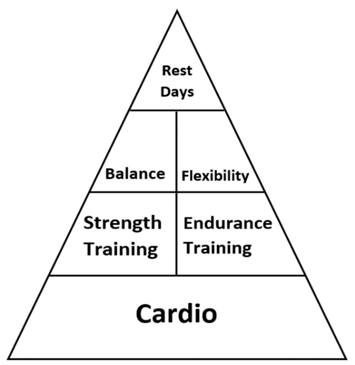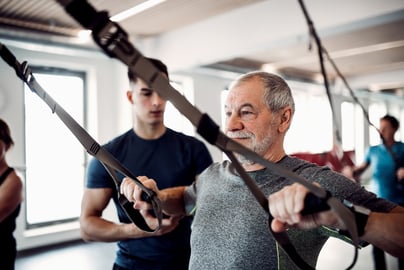 Working with a senior population, the most commonly asked question I probably get is “How can I strengthen my legs/back/core.. etc?” As exercise professionals, we already know how as far as the exercise prescription goes, but with seniors, modality often becomes a challenge. Our clients typically have a whole range of physical issues to deal with including joint pain, balance issues, and overall weakness so the traditional sit-to-stand exercises aren’t always applicable. That’s where the TRX suspension training system comes into play.
Working with a senior population, the most commonly asked question I probably get is “How can I strengthen my legs/back/core.. etc?” As exercise professionals, we already know how as far as the exercise prescription goes, but with seniors, modality often becomes a challenge. Our clients typically have a whole range of physical issues to deal with including joint pain, balance issues, and overall weakness so the traditional sit-to-stand exercises aren’t always applicable. That’s where the TRX suspension training system comes into play.
The TRX was originally developed for Navy SEALS and other elite level soldiers and athletes, but over the years, it has worked its way into home gyms, rehab clinics, and even senior living communities. The TRX is portable, adjustable for all heights, allows you to control ROM, challenges core strength with almost every single exercise, and has hundreds of possible exercises your clients can enjoy.
When it comes to building strength in seniors, ACSM guidelines and other research will tell us that more repetitions are effective when it comes to older adult populations. But there is also evidence eccentric movements are also beneficial due to its reduced oxygen requirement lowering the metabolic demand, and the fact that muscles can move more weight in the lengthening phase versus the shortening phase (concentric).The TRX allows the use of both approaches to strength building, without any additional equipment, such as free weights.
For example, If I am working with a client who can only perform a few sit to stands by pushing off of their thighs or arm rests of a chair, simply prescribing more sit-to-stands may not be the best route, especially if the clients gets frustrated. Instead, I could place the client in a chair in front of a TRX, and use it for an assisted sit-to-stand! Simply have the client start standing up, and begin the descent down into the chair, making sure the hips are hinged back, the knees are bending and in alignment (as best as they can be) and have them sit as gently as possible. Then, perform the same exercise in reverse to stand up. Since the client already struggle to stand up without pushing, they can use the TRX to help pull themselves up, while pushing through the legs. Once the client has a feel for the exercise and can perform it safely, you could then start modifying the repetitions, intensity, and better yet, progress from sit-to-stand to a TRX assisted squat!
And that was just one example. If you have a client that’s looking to improve posture, a bit of upper body strength and core, the TRX row is a very easy to teach and effective. With the TRX adjusted to the proper height, have the client stand with the straps in both hands, with soft knees, shoulders down, and core engaged. Make sure you are standing behind them for safety purposes. Have client begin to lean back, allowing the elbows to leave their sides and begin to straighten out. Then, once the full ROM has been achieved, have the client drive their elbows back while squeezing the scapula together, returning to the starting position.
With limitless exercise possibilities, portability, and affordability, the TRX is perhaps the ultimate strength builder for seniors. The TRX company themselves have put out hundreds of videos on how to teach the exercises, ques, and progressions, so there are plenty of resources out there on how to use it. They even have their own certification courses! I would recommend any and all senior living communities to invest in the TRX and the education of their fitness professionals.


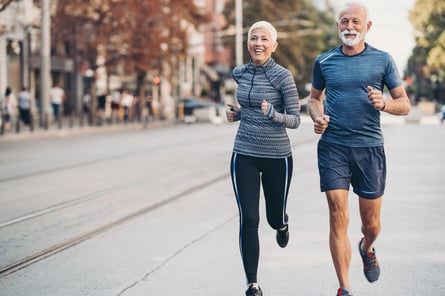 We all know that exercise is great for your health, but too often we think of improving our health as being able to move better, losing weight, having more energy, decreasing stress, or even improving our heart health, which are all great benefits don’t get me wrong! However, did you know that exercise can improve our memory and cognitive function as well? If not, you aren’t alone. The benefits that exercise can give our brain often tend to be overlooked.
We all know that exercise is great for your health, but too often we think of improving our health as being able to move better, losing weight, having more energy, decreasing stress, or even improving our heart health, which are all great benefits don’t get me wrong! However, did you know that exercise can improve our memory and cognitive function as well? If not, you aren’t alone. The benefits that exercise can give our brain often tend to be overlooked.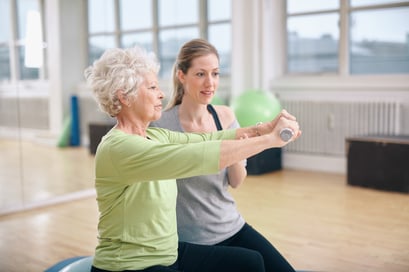 Working on one’s strength, agility, form, balance and flexibility are all so very important. Building/working on one’s strength helps prevent or lessen an injury. Using weights helps to strengthen the muscles. That being said, working the same muscles every day is not beneficial. Muscles need time to recover. Doing repetitive movements breaks the muscles down and causes wear and tear which leads to injury.
Working on one’s strength, agility, form, balance and flexibility are all so very important. Building/working on one’s strength helps prevent or lessen an injury. Using weights helps to strengthen the muscles. That being said, working the same muscles every day is not beneficial. Muscles need time to recover. Doing repetitive movements breaks the muscles down and causes wear and tear which leads to injury. 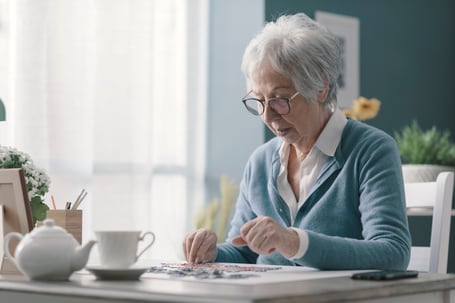 As we age there are many different changes that start to happen to our brain such as shrinkage, vasculature and cognition. With age, the brain shrinks and changes occur at all levels, from chemicals to morphology. Stroke, lesions, and dementia are all more common as people get older, as is memory impairment. Fortunately there are quite a few things we can do to help prevent or slow the process of some of those changes from happening. Regular exercise, a good diet, and low to moderate alcohol consumption, all of which minimize cardiovascular risk, appear to help the aging brain, as does increasing cognitive exertion in the form of schooling, games or meaningful activities. Physical and mental health may be the best defense against the effects of aging on the brain.
As we age there are many different changes that start to happen to our brain such as shrinkage, vasculature and cognition. With age, the brain shrinks and changes occur at all levels, from chemicals to morphology. Stroke, lesions, and dementia are all more common as people get older, as is memory impairment. Fortunately there are quite a few things we can do to help prevent or slow the process of some of those changes from happening. Regular exercise, a good diet, and low to moderate alcohol consumption, all of which minimize cardiovascular risk, appear to help the aging brain, as does increasing cognitive exertion in the form of schooling, games or meaningful activities. Physical and mental health may be the best defense against the effects of aging on the brain.
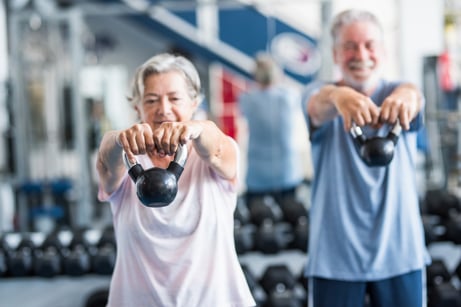 High intensity interval training (HIIT) sounds like something that is best for the 20-40 year old or athletes, however research begs to differ. Studies show that high intensity interval training is good for all ages, even if there are chronic health issues and you’re not a lifelong exerciser. In fact, HIIT workouts may be able to
High intensity interval training (HIIT) sounds like something that is best for the 20-40 year old or athletes, however research begs to differ. Studies show that high intensity interval training is good for all ages, even if there are chronic health issues and you’re not a lifelong exerciser. In fact, HIIT workouts may be able to 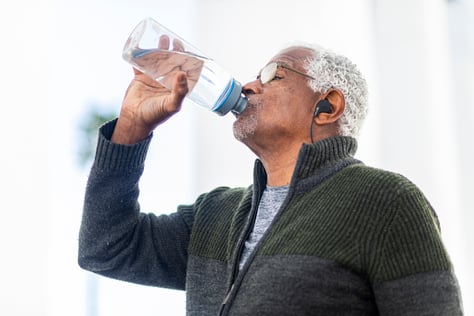 These are both great questions and very important to the older adult population. I hear all the time that people don’t like to drink water because they will need to go the restroom more. This can be an inconvenient especially during the night but in the long term we need to make sure we stay hydrated. Proper hydration is essential in keeping multiple systems of the body functioning properly. Most people need to drink at least three liters of water per day. You can get this water from many different sources including vegetables. If you can get one liter from what you eat during the day with a fruit and vegetable rich diet, then you will only need to drink two liters.
These are both great questions and very important to the older adult population. I hear all the time that people don’t like to drink water because they will need to go the restroom more. This can be an inconvenient especially during the night but in the long term we need to make sure we stay hydrated. Proper hydration is essential in keeping multiple systems of the body functioning properly. Most people need to drink at least three liters of water per day. You can get this water from many different sources including vegetables. If you can get one liter from what you eat during the day with a fruit and vegetable rich diet, then you will only need to drink two liters.
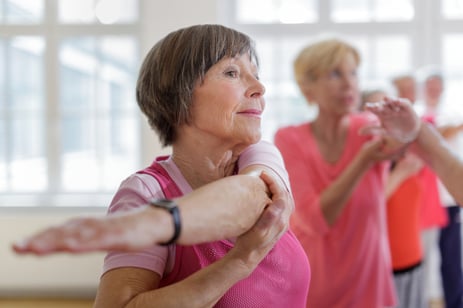 ‘’I am so stiff”. This is a statement heard quite often. More than likely, that stiffness or any type of unknown muscle pain may be result due to the lack of muscular flexibility. Flexibility is crucial in preventing muscle shortening while maintaining muscle length. Some additional benefits of flexibility are improved posture, physical performance, and strength. Stretching does not have to be done before or after an intense work out but should be incorporated within our everyday routine. If our muscles are warm, stretching can be done. I’d suggest immediately after a warm shower. Be sure to be grab a chair also. Yes, you can obtain the same results without being in a standing position.
‘’I am so stiff”. This is a statement heard quite often. More than likely, that stiffness or any type of unknown muscle pain may be result due to the lack of muscular flexibility. Flexibility is crucial in preventing muscle shortening while maintaining muscle length. Some additional benefits of flexibility are improved posture, physical performance, and strength. Stretching does not have to be done before or after an intense work out but should be incorporated within our everyday routine. If our muscles are warm, stretching can be done. I’d suggest immediately after a warm shower. Be sure to be grab a chair also. Yes, you can obtain the same results without being in a standing position.
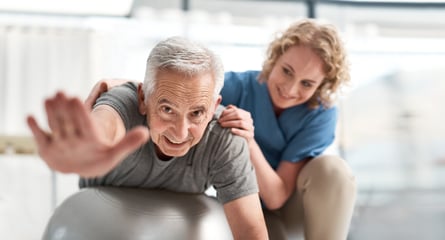 Improving balance can be tricky. Where do we start? What even is balance training? Standing on one leg? Walking more? It seems like everyone has their own idea of balance. What we do know, is that it becomes more important for active older adults to build and maintain balance with each passing year.
Improving balance can be tricky. Where do we start? What even is balance training? Standing on one leg? Walking more? It seems like everyone has their own idea of balance. What we do know, is that it becomes more important for active older adults to build and maintain balance with each passing year.
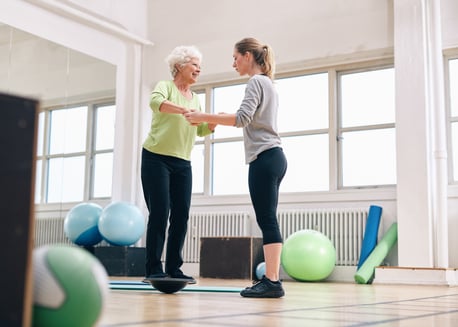 If you’ve ever worked with older adults you likely know about this love/hate relationship everyone has with any program labeled “Fall Prevention”. Residents are certainly interested in learning about how to prevent falls. They have a healthy fear of falling. But often times, they don’t want to move outside of their comfort zone to practice the things that will actually improve balance and fall prevention.
If you’ve ever worked with older adults you likely know about this love/hate relationship everyone has with any program labeled “Fall Prevention”. Residents are certainly interested in learning about how to prevent falls. They have a healthy fear of falling. But often times, they don’t want to move outside of their comfort zone to practice the things that will actually improve balance and fall prevention.
